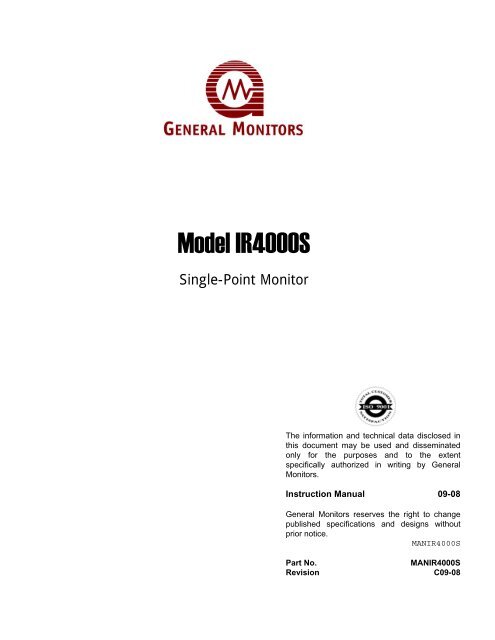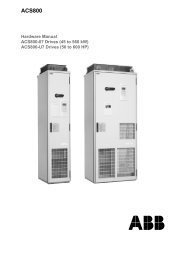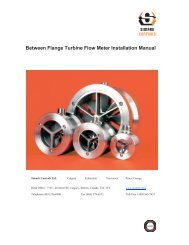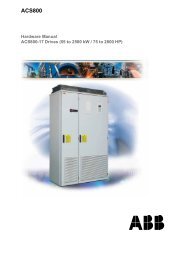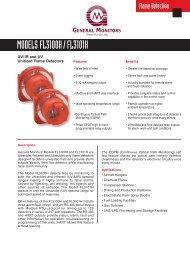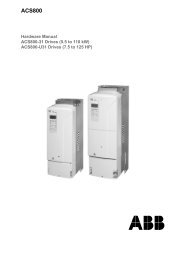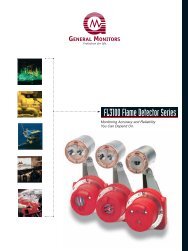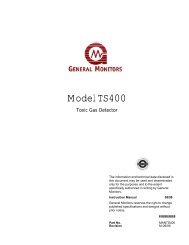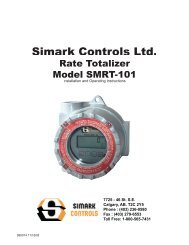Model IR4000S Instruction Manual - Simark Controls
Model IR4000S Instruction Manual - Simark Controls
Model IR4000S Instruction Manual - Simark Controls
- No tags were found...
Create successful ePaper yourself
Turn your PDF publications into a flip-book with our unique Google optimized e-Paper software.
<strong>Model</strong> <strong>IR4000S</strong>Single-Point MonitorThe information and technical data disclosed inthis document may be used and disseminatedonly for the purposes and to the extentspecifically authorized in writing by GeneralMonitors.<strong>Instruction</strong> <strong>Manual</strong> 09-08General Monitors reserves the right to changepublished specifications and designs withoutprior notice.MAN<strong>IR4000S</strong>Part No.MAN<strong>IR4000S</strong>Revision C09-08
<strong>Model</strong> <strong>IR4000S</strong>This page intentionally left blankii
<strong>Model</strong> <strong>IR4000S</strong>Table of ContentsQUICK-START GUIDE................................................................................................................. 1Cabling and Wiring ................................................................................................................................. 2Applying Power....................................................................................................................................... 41.0 INTRODUCTION..................................................................................................................... 51.1 Protection for Life ...................................................................................................................... 51.2 Special Cautions and Warnings ................................................................................................ 51.3 Installation, Operation, and Maintenance.................................................................................. 52.0 PRODUCT DESCRIPTION..................................................................................................... 62.1 <strong>IR4000S</strong> Monitor........................................................................................................................ 62.2 Features and Benefits ............................................................................................................... 63.0 INSTALLATION...................................................................................................................... 73.1 Unpacking the Equipment .........................................................................................................73.2 Mounting.................................................................................................................................... 83.3 Cabling and Wiring .................................................................................................................. 103.4 Applying Power and Starting Operation .................................................................................. 154.0 OPERATION AND CONFIGURATION................................................................................. 184.1 Overview.................................................................................................................................. 184.2 Gas Checking the IR400 ......................................................................................................... 204.3 Zeroing the IR400.................................................................................................................... 204.4 Calibrating the IR400............................................................................................................... 214.5 Setup ....................................................................................................................................... 224.6 Resetting the Relays (rSt ) ...................................................................................................... 235.0 MAINTENANCE....................................................................................................................255.1 Developing a Maintenance Schedule...................................................................................... 255.2 Zeroing and Recalibration .......................................................................................................255.3 Lubricating Threads and Seals................................................................................................ 255.45.5Maintaining the X/P Integrity.................................................................................................... 25Storage .................................................................................................................................... 266.0 TROUBLESHOOTING.......................................................................................................... 276.1 No Display on Power Up ......................................................................................................... 276.2 <strong>IR4000S</strong> Fault Codes and Remedies...................................................................................... 277.0 MODBUS INTERFACE......................................................................................................... 298.0 CUSTOMER SUPPORT ....................................................................................................... 309.0 APPENDIX............................................................................................................................ 319.1 Warranty .................................................................................................................................. 319.2 Specifications........................................................................................................................... 329.3 Ordering Information................................................................................................................ 35iii
<strong>Model</strong> <strong>IR4000S</strong>Table of FiguresFigure 1: <strong>IR4000S</strong> Outline and Mounting Dimensions, in inches [mm] ........................................................1Figure 2: <strong>IR4000S</strong> Terminal Block Connectors.............................................................................................3Figure 3: <strong>IR4000S</strong> Single-Point Monitor .......................................................................................................6Figure 6. <strong>IR4000S</strong> with IR400 Mounting Dimensions in inches [mm]..........................................................8Figure 4: <strong>IR4000S</strong> Outline and Mounting Dimensions, in inches [mm] ........................................................9Figure 5: <strong>IR4000S</strong> Terminal Block Connectors...........................................................................................11Figure 6: Push Type Terminal.....................................................................................................................12Figure 7: Screw Type Terminal Block Operation ........................................................................................13Figure 8: Connecting IR400 Signal Wires to the TB1 Block .......................................................................13Figure 9: Relay Protection for DC and AC Loads .......................................................................................14Figure 10: Front Panel Display and Indicators............................................................................................18Figure 11: <strong>IR4000S</strong> Menu Structure ...........................................................................................................19Table of TablesTable 1: IR400/<strong>IR4000S</strong> Installation Overview ............................................................................................. 7Table 2: TB3 Relay Contacts Energized/De-Energized Settings................................................................ 14Table 3: 24VDC Cable Lengths .................................................................................................................. 33Table 4: Analog Output Cable Lengths....................................................................................................... 33iv
05180539<strong>Model</strong> <strong>IR4000S</strong>Quick-Start GuideSpecial tools:• 5mm Allen wrench for cover (included with unit)• 0.1” flat-head screwdriver for wiring (included with unit)• Adjustable wrench for conduit or cable gland connections (not included).Mounting:Allow convenient access to the front panel display and magnet switch input.Leave sufficient room to attach cabling. Keep cable run distances belowspecified limits.Although the <strong>Model</strong> <strong>IR4000S</strong> is RFI-resistant, where possible, mount it awayfrom heavy power cabling, radio transmitters, or similar equipment.Where possible, locate the <strong>IR4000S</strong> away from excessive heat and vibration andas free as possible from wind, dust, water, and direct sunlight.MODEL IR4000M P/N 32580CALIBRATION PROCEDURE1. HAVE DETECTOR IN CLEAN AIR2. APPLY MAGNET, AND WAIT FOR "AC"ON DISPLAY3. REMOVE MAGNET, WHEN d# ISDISPLAYED, APPLY MAGNET TOSELECT DETECTOR #4. REMOVE MAGNET, FLASHING "AC"IS DISPLAYED5. WHEN "AC" IS STEADY, APPLY GAS6. WHEN GAS IS DETECTED, "CP" ISDISPLAYED7. WHEN CALIBRATION IS COMPLETE,"CC" IS DISPLAYED8. REMOVE GASALARM LEDWARN LEDS/NCONFIGYEAR OF CONSTRUCTIONMANFigure 1: <strong>IR4000S</strong> Outline and Mounting Dimensions, in inches [mm]1
<strong>Model</strong> <strong>IR4000S</strong>Cabling and WiringWARNING: Seal conduit entries per Class I hazardous location requirements.Under NO circumstances should equipment be connected or disconnected whenunder power. Equipment damaged in this manner is not covered under warranty.CAUTION: Do not use a sealant that contains acetic acid. Use precautions toavoid equipment damage by static electricity.• The cable armor must be connected to safety earth in the safe area.• The cable screen (drain wire) must be connected to an instrument earthin the safe area.• Three-wire shielded cable is recommended for power and signalconnections.• The push terminal blocks accept 14 AWG to 24 AWG stranded or solidwire. The screw terminal blocks accept 12 to 28 AWG.• Power to the <strong>IR4000S</strong> must remain OFF until all wiring is completed andthe start-up readiness checklist has been verified. Wire installationorder:1. Common (COM) and Field Ground (FG) wires2. Modbus (MOD), Analog (mA), CAL and relay wires (RLY,ALARM, WARN, and FAULT)3. 24 VDC power2
<strong>Model</strong> <strong>IR4000S</strong>TB1DetectorTB2HostTB3RelayFigure 2: <strong>IR4000S</strong> Terminal Block ConnectorsTB1 - Detector TerminalPin # SIGNAL1 4-20 mA IN2 CAL IN3 COM4 FGND5 MOD +6 MOD -7 COM8 +24 V9 +24 VTB2 - HOST TerminalPin # SIGNAL1 4-20 mA out2 MOD -3 MOD +4 NOT USED5 NOT USED6 CAL/ARGC7 RLY RST8 COM9 +24 V INTB 3 - Relay TerminalPin # DE-ENERGIZED ENERGIZED1 ALARM-NC ALARM-NO2 ALARM-C ALARM-C3 ALARM-NO ALARM-NC4 WARN-NC WARN-NO5 WARN-C WARN-C6 WARN-NO WARN-NC7 FAULT-NC FAULT-NO8 FAULT-C FAULT-C9 FAULT-NO FAULT-NC3
<strong>Model</strong> <strong>IR4000S</strong>Applying PowerBefore applying power for the first time, check the following:• Verify that the junction box lid is securely installed, unless the area hasbeen declassified.• Inhibit any external devices, such as Trip Amplifiers, PLC devices orDCS systems.• Verify that the power supply is connected properly. The <strong>Model</strong> <strong>IR4000S</strong>and IR400 are powered by +24 VDC (20 to 36 VDC voltage range). The<strong>IR4000S</strong> will display a fault code of bF6 if the power supply voltage isbelow 18.5 VDC.• Power-up Sequence1. 000 and Alarm indicator on for 1 second2. All display elements (8.8.8.) and both Alarm and Warn indicatorson for 2 seconds3. Software revision on for 2 seconds (for example revision A willdisplay: r A)4. bSU (base Start Up) for 12 seconds5. SU (IR400 Start Up) for 1 minute, 45 seconds6. Gas concentration in % LELPlease consult the remainder of the manual for more information on calibration,operation, and other product features.NOTE: The <strong>IR4000S</strong> is compatible with point IR detectors <strong>Model</strong> IR400 and<strong>Model</strong> IR2100. This manual refers to the connected detector as IR400throughout but all instructions also apply to the IR2100 unless otherwisenoted.4
<strong>Model</strong> <strong>IR4000S</strong>1.0 Introduction1.1 Protection for LifeGeneral Monitors’ mission is to benefit society by providing solutions throughindustry-leading safety products, services and systems that save lives andprotect capital resources from the dangers of hazardous flames, gases andvapors.The safety products you have purchased should be handled carefully andinstalled, calibrated and maintained in accordance with this instruction manual.Remember, these products are for your safety.1.2 Special Cautions and WarningsThis instruction manual includes numerous cautions and warnings that areincluded to prevent injury to personnel and prevent damage to equipment.WARNING: TOXIC, COMBUSTIBLE, AND FLAMMABLE GASES ANDVAPORS ARE VERY DANGEROUS. USE EXTREME CAUTION WHEN THESEHAZARDS ARE PRESENT.1.3 Installation, Operation, and MaintenanceBefore power up, verify wiring, terminal connections and stability of mounting forall integral safety equipment.Proper system operation should be verified by performing a full, functional test ofall component devices of the safety system, ensuring that the proper levels ofalarming occur. Fault/malfunction circuit operation should be verified.Periodic testing/calibrating should be performed per the manufacturer’srecommendations and instructions.When testing produces results outside of the manufacturer’s specifications, recalibrationor repair/replacement of the suspect device(s) should be performed asnecessary. Calibration check and calibration intervals should be independentlyestablished through a documented procedure, including a calibration logmaintained by plant personnel, or third party testing services.5
<strong>Model</strong> <strong>IR4000S</strong>2.0 Product Description2.1 <strong>IR4000S</strong> MonitorFigure 3: <strong>IR4000S</strong> Single-Point MonitorThe <strong>Model</strong> <strong>IR4000S</strong> Single-Point Monitor is a display and user interface for the<strong>Model</strong> IR400 point IR gas detector. The monitor allows local calibration anddisplays gas concentration. Relays are optional. The relays provide output forAlarm, Warn, and Fault conditions.2.2 Features and BenefitsThe <strong>IR4000S</strong> system enhances the features and benefits of the IR400 in severalimportant ways:• Local interface provides ease of maintenance and accessibility• Bright display permits clear indication• Explosion-proof enclosure and magnetic interface allow installation andcalibration in hazardous locations• Optional 8 Amp relays expand system functions, potentially eliminatingthe need for additional equipment such as a PLC6
<strong>Model</strong> <strong>IR4000S</strong>3.0 InstallationCAUTION: The <strong>IR4000S</strong> Single-Point Monitor contains components that can bedamaged by static electricity. Special care must be taken when wiring the systemto ensure that only the connection points are touched.Installation and Maintenance must be carried out by suitably skilled andcompetent personnel only.Special Tools• 5mm Allen wrench for lid (included with unit).• 0.1” flat-head screwdriver for terminal block connections (included withunit).• Adjustable wrench for conduit or cable gland connections (not included).Installation StepRefer to Section1. Unpack the equipment and prepare for installation Section 3.12. Attach each IR400 to a junction box or directly to the<strong>IR4000S</strong>3. Mount the IR400, <strong>IR4000S</strong> units in place. (Steps 3 and4 can be swapped if it is easier to attach cabling beforethe units are mounted in place.)Section 3.3Section 3.24. Wire the <strong>IR4000S</strong> to the IR400 and any remote devices Section 3.35. Power on the equipment Section 3.46. Gas check or calibrate the IR400 Section 4.2 or 4.4Table 1: IR400/<strong>IR4000S</strong> Installation Overview3.1 Unpacking the EquipmentAll equipment shipped by General Monitors is packaged in shock absorbingcontainers, which provide considerable protection against physical damage. Thecontents should be carefully removed and checked against the packing list.If any damage has occurred or there is any discrepancy in the order, pleasenotify General Monitors as soon as possible. All subsequent correspondencewith General Monitors must specify the equipment part number and the serialnumber. Both are on the cover of the <strong>IR4000S</strong>.7
CALIBRATION PROCEDURE1. HAVE DETECTOR IN CLEAN AIR2. APPLY MAGNET, AND WAIT FOR "AC"ON DISPLAY3. REMOVE MAGNET, WHEN d# ISDISPLAYED, APPLY MAGNET TOSELECT DETECTOR #4. REMOVE MAGNET, FLASHING "AC"IS DISPLAYED5. WHEN "AC" IS STEADY, APPLY GAS6. WHEN GAS IS DETECTED, "CP" ISDISPLAYED7. WHEN CALIBRATION IS COMPLETE,"CC" IS DISPLAYED8. REMOVE GASALARM LEDYEAR OF CONSTRUCTIONWARN LED<strong>Model</strong> <strong>IR4000S</strong>3.2 MountingAllow convenient access to the monitor in order to input local configurations andcalibrate via the magnetic switch on the cover.Leave sufficient room to attach cabling. Keep cable run distances belowspecified limits.Although the <strong>Model</strong> <strong>IR4000S</strong> is RFI-resistant, where possible mount it away fromheavy power cabling, radio transmitters, or similar equipment.Locate the <strong>IR4000S</strong> away from concentrated sources of heat or light. It should bemounted in areas that are free from excessive vibration and as free as possiblefrom wind, dust, water, and direct sunlight.MODEL IR4000M P/N 3258005180539S/NCONFIGMANFigure 4. <strong>IR4000S</strong> with IR400 Mounting Dimensions, in inches [mm]8
05180539<strong>Model</strong> <strong>IR4000S</strong>MODEL IR4000M P/N 32580CALIBRATION PROCEDURE1. HAVE DETECTOR IN CLEAN AIR2. APPLY MAGNET, AND WAIT FOR "AC"ON DISPLAY3. REMOVE MAGNET, WHEN d# ISDISPLAYED, APPLY MAGNET TOSELECT DETECTOR #4. REMOVE MAGNET, FLASHING "AC"IS DISPLAYED5. WHEN "AC" IS STEADY, APPLY GAS6. WHEN GAS IS DETECTED, "CP" ISDISPLAYED7. WHEN CALIBRATION IS COMPLETE,"CC" IS DISPLAYED8. REMOVE GASALARM LEDWARN LEDS/NCONFIGYEAR OF CONSTRUCTIONMANFigure 5: <strong>IR4000S</strong> Outline and Mounting Dimensions, in inches [mm]Applying Sealants to Conduit EntriesPlease keep the following warnings and cautions in mind when you install the<strong>IR4000S</strong>, to make sure that the equipment maintains the appropriate seals for aClass I hazardous location.WARNING: Each conduit run from an IR400 junction box or <strong>IR4000S</strong> housingwithin a hazardous location (and from a hazardous to a non-hazardous location)must be sealed so that gases, vapors, and/or flames cannot pass beyond theseal. The purpose of seals in a Class I hazardous location is to prevent thepassage of gases, vapors, or flames from one electrical installation to anotherthrough the conduit system. For information on Class I location seals, see NECArticles 501-5 and 500-3d.WARNING: Unused cable entry holes must be sealed with approved explosionproofstopping plugs. Red caps supplied by General Monitors are for dustprotection only, and must not be left on the unit when installed.9
<strong>Model</strong> <strong>IR4000S</strong>CAUTION: Acetic acid will cause damage to metal components, metalhardware, ceramic ICs, etc. If damage results from the use of a sealant thatcontains acetic acid (RTV silicone), the warranty will be void.To prevent corrosion due to moisture or condensation, it is recommended thatthe conduit connected to the <strong>Model</strong> <strong>IR4000S</strong> housing be sealed or contain adrain loop.3.3 Cabling and Wiring3.3.1 Cabling Safety NoticesCAUTION: The <strong>IR4000S</strong> contains components that can be damaged by staticelectricity. Special care must be taken when wiring the system to ensure that onlythe connection points are touched.WARNING: Under NO circumstances should equipment be connected ordisconnected when under power. This is contrary to hazardous area regulationsand may also lead to serious damage to the equipment. Equipment damaged inthis manner is not covered under warranty.WARNING: For safety, ground cabling must always be connected first, beforeother cabling is connected. The 24 VDC power cabling should be connected last(and disconnected first). Power supply connections to the <strong>IR4000S</strong> must remainOFF until all wiring is completed and the start-up readiness checklist has beenverified. Refer to the manual for the power supply being used for instructions.3.3.1.1 European Union (EU) Approved Cable Armor and ScreensInterconnecting cables must have an overall screen or screen and armor. CablesBS5308 Part 2, Type 2 or equivalent are suitable. Note that the terms ‘screen’and ‘shield’ are equivalent for the purpose of this manual. The cable armor mustbe terminated in a suitable cable gland at the detector to ensure a positiveelectrical connection.3.3.1.2 Cable Termination in Non-Hazardous AreasThe cable armor must be connected to safety earth in the safe area.The cable screen (drain wire) must be connected to an instrument earth in thesafe area.The power supply OV return must be connected to an instrument earth in thesafe area.The interconnecting cables should be segregated from power and other noisycables. Avoid proximity to cables associated with radio transmitters, welders,switch mode power supplies, inverters, battery chargers, ignition systems,generators, switch gear, arc lights and other high frequency or high powerswitching process equipment.In general, maintain separation of at least 1 meter between the instrument andother cables. Greater separations are required where long parallel cable runs areunavoidable. Avoid running instrument cable trenches close to lightningconductor earthing pits.10
<strong>Model</strong> <strong>IR4000S</strong>Complete all cable insulation testing before connecting the cable at either end.3.3.2 WiringFigure 6 shows the <strong>IR4000S</strong> terminal block connectors TB1, TB2 and TB3, whichhold the wiring that connects the <strong>IR4000S</strong> to the IR400 (Detector), local alarms(Relay), and control room equipment (HOST). You must remove the cover fromthe <strong>IR4000S</strong> enclosure to access these connectors. The inside of the coverincludes a label that lists the function of each connector location.WARNING: For safety, ground cabling must always be connected first, beforeother cabling is connected. The 24 VDC power cabling should be connected last(and disconnected first). Power supply connections to the <strong>IR4000S</strong> must remainOFF until all wiring is completed and the start-up readiness checklist has beenverified. Refer to the manual for the power supply being used for instructions.TB1DetectorTB2HOSTTB3RelayFigure 6: <strong>IR4000S</strong> Terminal Block Connectors11
<strong>Model</strong> <strong>IR4000S</strong>TB1 - Detector TerminalPin # SIGNAL1 4-20mA IN2 CAL IN3 COM4 FRAME GND5 MOD +6 MOD -7 COM8 +24V9 +24VTB2 - Host TerminalPin # SIGNAL1 4-20mA out2 MOD -3 MOD +4 NOT USED5 NOT USED6 CAL/ARGC7 RLY RST8 COM9 +24V INTB3 - Relay TerminalPin # DE-ENERGIZED ENERGIZED1 ALARM-NC ALARM-NO2 ALARM-C ALARM-C3 ALARM-NO ALARM-NC4 WARN-NC WARN-NO5 WARN-C WARN-C6 WARN-NO WARN-NC7 FAULT-NC FAULT-NO8 FAULT-C FAULT-C9 FAULT-NO FAULT-NCCAUTION: Contact with PCB components should be avoided to preventdamage by static electricity. All wire connections are made to the terminal blocks.NOTE: It is recommended that you use three-wire shielded cable to make powerand signal connections to the <strong>Model</strong> <strong>IR4000S</strong>. The push terminal blocksaccept 14 AWG to 20 AWG stranded or solid wire. The screw terminalblocks accept 12 AWG to 18 AWG. You must strip each wire beforewiring the <strong>IR4000S</strong>. Remove 3/8 to 1/2 inch (10 to 12 mm) of insulation.To Attach Wiring to an <strong>IR4000S</strong> Terminal Block:1. Remove the <strong>IR4000S</strong> enclosure cover by loosening the four captive screwsand lifting the cover straight up.2. For push terminals, insert a screwdriver into the orange tab and press down,opening the terminal. For screw terminals, turn the screw counterclockwise toopen.3. Insert the stripped wire into the terminal. For push terminals, release the orangetab to clamp the wire in the terminal. For screw terminals, turn the screwclockwise to clamp the wire. GENTLY tug on the wire to make sure it is lockedsecurely in place.Figure 7: Push Type Terminal12
<strong>Model</strong> <strong>IR4000S</strong>Figure 8: Screw Type Terminal4. Connect the wires in the following order:• Common (COM) and Field Ground (FG) wires• Modbus (MOD), Analog (mA), CAL and relay wires (RLY, ALARM,WARN, and FAULT)• 24 VDC powerNOTE: If the 4-20 mA Out (TB-2, pin 1) is not being used, a jumper must beplaced between TB-2, pin 1 and a COM pin, such as TB-2, pin 8 tocomplete the AO circuit.5. When wiring is complete, replace the <strong>IR4000S</strong> cover and tighten the four captivescrews.IR4000 TB1Terminal BlockIR400ShieldBLACK COMGREEN/YELLOW FGRED +24VWHITE 4-20mABROWN CALBLUE MOD1+BLUE/WHITE MOD1-ShieldCOM (pin 7)+24V (pin 8)4-20mA IN (pin 1)CAL IN (pin 2)COM (pin 3)MOD+ (optional)MOD- (optional)Figure 9: Connecting IR400 Signal Wires to the TB1 Block3.3.3 Connecting Alarm Relay Devices to the TB3 BlockTerminal block TB3 contains the connections for the relay contacts for alarmequipment such as sirens. It is included on an optional circuit board module. The13
<strong>Model</strong> <strong>IR4000S</strong>functioning of the Alarm and Warn relay connections varies depending onwhether the relays are configured as Energized or De-Energized.NOTE: The default <strong>IR4000S</strong> configuration menu setting for the Warn and Alarmrelays is De-Energized. For further information, see relay configurationinformation in Section 4.5.1. The Fault relay is normally Energized. It willchange state after power-up.Use the following table as a guide for determining the Normally Open (NO) andthe Normally Closed (NC) contacts for the Energized versus De-Energizedsettings.Relay Type TB3 position De-Energized EnergizedAlarmWarnFault1 Normally Closed Normally Open2 Common Common3 Normally Open Normally Closed4 Normally Closed Normally Open5 Common Common6 Normally Open Normally Closed7 (Not Applicable: Normally Open8 Fault Relay AlwaysCommon9Energized) Normally ClosedTable 2: TB3 Relay Contacts Energized/De-Energized SettingsWARNING: Relay contacts must be protected against transient and over-voltageconditions (see Figure 10).Figure 10: Relay Protection for DC and AC LoadsEuropean Union (EU) Approved Applications: The ALARM relay contact ratingsare 8 A, 30 VRMS / 42.4 V peak or 8 A @ 30 VDC resistive max.North American Approved Applications: The ALARM relay contact ratings are8 A @ 240 VAC and 8 A @ 30 VDC resistive max.14
<strong>Model</strong> <strong>IR4000S</strong>3.4 Applying Power and Starting OperationOnce the mounting, cabling and alarm relay installation is complete, yourIR400/<strong>IR4000S</strong> detection system is ready to begin the power-on sequence.Please review this section carefully before powering on your GM standalonedetectors or your IR400/<strong>IR4000S</strong> Monitor system.3.4.1 Start-up Readiness ChecklistPrior to applying power to the system for the first time, check the following itemsfor a stand-alone IR400 detector and for an <strong>IR4000S</strong> monitor configuration.NOTE: The +24 V wire(s) to the power supply (supplies) should be connectedafter the readiness checklist is verified, to protect the system fromshorting. Since the IR400 and <strong>IR4000S</strong> are designed to monitorcontinuously for hydrocarbon gas leaks, they do not have powerswitches, to prevent accidental system shutdown.1. Verify that all the signal wiring (except for +24 VDC) is installed correctly:• From each IR400 to a directly attached junction box, FMD or<strong>IR4000S</strong>• Between IR400 junction boxes, FMDs, <strong>IR4000S</strong>’s, and control roomdevices• From each <strong>IR4000S</strong> or FMD to Alarm relays (optional)2. If the analog (4-20 mA) output is not used, then the IR400 white signalwire must be connected to ground to prevent a fault condition (F4).3. Make sure that the <strong>IR4000S</strong> and/or junction box lids are securelyinstalled, unless the area has been declassified.4. Make sure to inhibit any external devices, such as Trip Amplifiers, PLCdevices or DCS systems until after the start-up sequence is completed.5. Once you are ready to begin the start-up, verify that the power supply isconnected properly. The <strong>IR4000S</strong> and IR400 are powered by +24 VDC(20 to 36 VDC voltage range). The IR400 optional LED will output a lowvoltage fault at 18.5 VDC or below.15
<strong>Model</strong> <strong>IR4000S</strong>3.4.2 Start-up Process for an <strong>IR4000S</strong> SystemNOTE: Powering on and off of the <strong>IR4000S</strong> and IR400 units is controlled fromthe external power supply; refer to the power supply manual forinstructions.If you have any problems in the start-up or testing of the detector system, pleaserefer to Section 6.0 “Troubleshooting” or contact General Monitors TechnicalSupport. The <strong>Model</strong> IR400 should be allowed to stabilize for approximately 60minutes while each detector attains the proper operating temperature.<strong>IR4000S</strong> display sequence on power-up:1. 000 and Alarm indicator on for 1 second2. All display elements (8.8.8.) and both Alarm and Warn indicators on for 2seconds3. Software revision on for 2 seconds (example: r A)4. bSU (base Start Up) for 12 seconds5. SU (IR400 Start Up) for 1 minute, 45 seconds6. Gas concentration in % LELIf a fault code is displayed after power up, please refer to Section 6.0“Troubleshooting”3.4.3 <strong>IR4000S</strong> Start-up Operation and Configuration TasksIn order to make sure that the IR400 detector and <strong>IR4000S</strong> menu functions areworking correctly, you should perform several tasks immediately after the systemis powered on. This section points you to detailed instructions for completingseveral start-up operation and configuration tasks using the <strong>IR4000S</strong> menusystem.1. Zero each connected IR400. Zeroing eliminates any background gasfluctuations.• For instructions, see Zeroing the IR400 in Section 4.3.2. Perform a gas check test for each connected IR400. Verify that the IR400is measuring a known % LEL correctly by placing it in Gas Check Modeusing the <strong>IR4000S</strong> menu options.• You will need to use the GM Gas Check Kit (P/N 31468) to complete thistask.• For instructions, see Gas Checking the IR400 in Section 4.2.16
<strong>Model</strong> <strong>IR4000S</strong>3. (Optional) Configure additional <strong>IR4000S</strong> settings, as needed. You maywish to configure additional operating parameters directly after start-up, oryou can use the default settings initially and change them later on.• For a summary of all the <strong>IR4000S</strong> Menu Configuration options, see thetopic Setup in Section 4.5.17
<strong>Model</strong> <strong>IR4000S</strong>4.0 Operation and Configuration4.1 OverviewThe <strong>Model</strong> <strong>IR4000S</strong> Single-Point Monitor front panel includes a digital display,Alarm and Warn indicators. The panel displays a set of menu options thatprovide the user with the most flexible detector system possible.Alarm IndicatorP/N 31840MODEL IR40007 W MAX. , CONTACT RATINGS : SEE MANUAL3-Digit DisplayWarning IndicatorCAUTION:DO NOT OPEN WHEN ANEXPLOSIVE GAS ATMOSPHERE IS PRESENT. DONOT OPEN WHILE ENERGIZED. READ ANDUNDERSTAND INSTRUCTION MANUAL BEFOREOPERATING OR SERVICING.S/NCONFIGMANFigure 11: Front Panel Display and IndicatorsThe <strong>IR4000S</strong> menus allow you to complete many operational tasks for the IR400.• Reset Alarm and Warn relays• Zero, calibrate, or initiate a gas check• Select Alarm and Warn relay settingsNOTE: If you begin navigating within the <strong>IR4000S</strong> menus, then leave the deviceidle without returning to normal operation, a timeout will occur after 15minutes and the <strong>IR4000S</strong> will display a fault code F8. Reapplying themagnet to the GM logo will clear the F8 fault.18
<strong>Model</strong> <strong>IR4000S</strong>Figure 12: <strong>IR4000S</strong> Menu Structure19
<strong>Model</strong> <strong>IR4000S</strong>4.2 Gas Checking the IR400You can ‘gas check’ an IR400 unit to verify response without tripping relays.During gas check mode, the Alarm and Warn relays are disabled.CAUTION – The analog output from the <strong>IR4000S</strong> is directly connected to theIR400 being used and this analog output will indicate gas present when the<strong>IR4000S</strong> is in Gas Check Mode. Make sure that any equipment monitoring theanalog output is in alarm bypass mode before performing a gas check.To Gas Check the IR400 Unit:4.2.1 Open the main menu. Place the magnet on the <strong>IR4000S</strong> GM logo toaccess the main menu options.4.2.2 Select Gas Check. Once the Gas Check (- - -) option appears, removethe magnet. The % LEL display will flash. Apply gas. After gas isremoved, the <strong>IR4000S</strong> will return to normal operation and display % LEL.4.3 Zeroing the IR400You can ‘zero’ the IR400 detector in order to eliminate any background gasfluctuations, using the ZrO option. During zeroing mode, the analog output for theIR400 is kept at 1.5 mA and the Alarm and Warn relays are disabled.To Zero the IR400 Unit:1. Open the main menu. Place the magnet on the <strong>IR4000S</strong> GM logo to accessthe main menu options.2. Select zeroing. Once the ZrO option appears, remove the magnet. AC(Automatic Calibration) will flash for 20 seconds. When zeroing is complete,the display shows zero complete by displaying 0C for 10 seconds. The<strong>IR4000S</strong> will then return to normal operation and display % LEL.NOTE: Reapplying the magnet during the ZrO option will return the unit tonormal operation. Reapplying the magnet while 0C is displayed will startthe calibration cycle.20
<strong>Model</strong> <strong>IR4000S</strong>4.4 Calibrating the IR400You can calibrate the IR400 which is connected to the <strong>IR4000S</strong> unit in order tomake sure the LEL measurements are accurate. During calibration, the IR400analog output is 1.5 mA, in order to disable the Alarm and Warn relays.Equipment required: Calibration cup, tubing, calibration gas tank with regulator.To Calibrate the IR400 Detector:1. The IR400 must be in a “no gas” condition initially; it will be zeroed as part ofcalibration.2. Open the main menu. Place the magnet on the <strong>IR4000S</strong> GM logo to movefrom normal operation to the main menu options.3. Select Automatic Calibration. Once AC appears, remove the magnet. ACwill flash, and zeroing will start. When zeroing is complete, 0C will show onthe display to confirm zero complete, then the display will change to AC.4. Apply gas to the detector. Apply a 50% LEL gas using a Gas Check Kitwith portable purge calibrator equipment.• The display will show a steady “CP” (Calibration in Progress). If the gasdrops below 20% LEL, the display will revert to a flashing ”CP”.• In about one to two minutes, depending on gas flow, the IR400 will completecalibrating and display “CC” (Calibration Complete).5. Remove the gas. You will continue to see “CC” until the gas gets below 5%of full scale. The unit will then return to normal operation.If the calibration does not proceed normally, such as if the gas was too low ortoo late in getting to the IR400, the IR400 will show a calibration fault (F6).21
<strong>Model</strong> <strong>IR4000S</strong>NOTE: Once gas has been applied, it is not possible to stop calibration. If no gasis applied for 6 minutes after calibration is selected from the <strong>IR4000S</strong>menus, the detector automatically reverts to a fault condition. A fault alsooccurs if the gas is not removed within 6 minutes from the beginning ofcalibration. You must re-apply the magnet over the GM logo andrecalibrate.If no gas has been applied, calibration can be aborted by reapplying themagnet.4.5 SetupThis section describes the tasks that you can accomplish using the SE (Setup)submenu, which provides numerous configuration options. The second half of the<strong>IR4000S</strong> menu shows the SE (Base) submenu, which provides moreconfiguration options.Lo and Hi Submenus. These submenus configure the % LEL setpoint for theWarn and Alarm relays, as well as Energized/De-energized, and Latching/Non-Latching.4.5.1 Configuring Warn and Alarm Relay SettingsThe <strong>IR4000S</strong> menus allow you to configure the following Alarm and Warn relaysettings: Latching versus Non-Latching, Energized versus De-Energized, and the% LEL setpoint.The default Warn relay settings are Non-Latching, De-Energized, 30% LELsetpoint.The default Alarm relay settings are Latching, De-Energized, 60% LEL setpoint.NOTE: The settings you select are applied to all connected, online IR400 units.The Warn relay setpoint must be set lower than the Alarm relay setpoint;neither the Warn nor Alarm setpoints can be higher than 60% LEL.To Change the Warn and Alarm Relay Settings:The steps to change the Alarm and Warn relay settings are the same.1. Open the main menu. Place the magnet on the <strong>IR4000S</strong> GM logo tomove from normal operation to the main menu options.2. Select SE from the main menu. Once the SE option appears, removethe magnet to open the SE submenu.3. Apply magnet to select Lo or Hi. The Lo submenu includes options toconfigure the Warn relay settings; the Hi submenu includes identicaloptions to configure the Alarm relay settings.22
<strong>Model</strong> <strong>IR4000S</strong>4. Configure the settings for the Lo or Hi submenu. Three relay settingswill appear in turn for the Lo or Hi submenu. Once you select eachsetting using the magnet, you will move to the next setting, then toFinish.• The first relay setting is En or dE for energized or de-energized,respectively. Apply and remove the magnet to select En or dE.• The second relay setting is La or nL for latching or non-latching,respectively. Apply and remove the magnet to select La or nL.• The third relay setting is the % LEL setpoint. Available Lo setpointsare from 5 to the Hi setpoint in 5% LEL increments. Available Hisetpoints are from the Lo setpoint to 60% LEL. Apply and removethe magnet to select the setting. To finish and advance to the nextoption, apply the magnet when Fi (Finish) appears.5. Return to normal operation. When Lo and Hi settings are completed,the <strong>IR4000S</strong> will display Lo, Hi, and Fi. To return to normal operation,apply and remove the magnet when Fi (finish) appears.4.6 Resetting the Relays (rSt )NOTE: If the unit was ordered without relays, changing the relay settings will stillaffect the operation of the high and low LEDs on the display.The rSt main menu option is provided to reset Warn and Alarm relays; if theserelays are configured as latching, they must be manually reset after an Alarmoccurs. The default setting for the <strong>IR4000S</strong> Warn relay is non-latching, and thedefault setting for the Alarm relay is latching.NOTE: Red indicators above and below the digital display are on when theAlarm and Warn relays are active. Latching relays can only be reset ifthe gas concentration has fallen below the respective relay setpoint.To Reset the Relays:1. Open the main menu. Place the magnet on the <strong>IR4000S</strong> GM logo tomove from the run display to the main menu options.2. Select the rSt option. After a few seconds, the rSt main menu optionappears. Remove the magnet to select this option.The message r appears briefly to confirm that the relays are being cleared.Then the unit returns to the default normal operation.23
<strong>Model</strong> <strong>IR4000S</strong>Alternate Methods for Resetting the RelaysIn addition to the rSt menu option, the relays can be reset by connecting anormally open switch between the <strong>IR4000S</strong> terminal TB2-7 and TB2-8 (relayreset and COM) momentarily using a General Monitors explosion-proofswitch (P/N 30051-1).24
<strong>Model</strong> <strong>IR4000S</strong>5.0 MaintenanceWARNING: Disconnect or inhibit external devices such as trip amplifiers, PLC’s,or DCS systems before performing any maintenance.NOTE: The system’s full two-year warranty will be voided if customer personnelor third parties damage the system during repair attempts ormaintenance activities.5.1 Developing a Maintenance ScheduleMaintenance requirements will vary with each installation; General Monitorsrecommends that a schedule for periodic maintenance be established andfollowed, and that a maintenance logbook be kept for each unit in operation.More frequent cleaning and calibration checks are recommended if theequipment is impacted by unusual environmental conditions such as mudcollecting on the detector windows, detectors accidentally being painted over,etc.General Monitors is not implying that the customer should expect problems withdetector life or stability, but calibration checks ensure the integrity of the lifeprotecting equipment.5.2 Zeroing and RecalibrationFor detailed instructions on initiating gas checks, zeroing and calibration using the<strong>IR4000S</strong> menus, see Sections 4.2 - 4.4.5.3 Lubricating Threads and SealsIf the neoprene rubber gasket (O-ring) in the cover of the <strong>IR4000S</strong> enclosure isfound dry, it should also be lubricated with the lubricant/sealant that is includedwith the IR400/<strong>IR4000S</strong> units, or is available on order from General Monitors(P/N 610-010).As an alternative to grease, PTFE (Teflon) tape may be used.5.4 Maintaining the X/P IntegrityThe <strong>Model</strong> <strong>IR4000S</strong> is rated explosion-proof for use in hazardous locations.Before the cover of the <strong>IR4000S</strong> is removed, or the cover bolts are loosened andpower is to be left on, it is necessary to declassify the area. When replacing thecover, the gap between the lid and the housing should be less than .0015 inch(.038 mm). Make sure that the flame-path is clear of dirt and debris beforereplacing the cover. Tighten the cover bolts to a torque setting of 50 inch-pounds.25
<strong>Model</strong> <strong>IR4000S</strong>Use a feeler gauge to ensure the gap between the cover and the housing is lessthan .0015 inch (.038 mm).There are four entry holes in the <strong>IR4000S</strong> housing. These holes can be used toattach an IR400 or IR2100 unit directly, as well as for wiring conduits to alarmrelays and control room equipment.Each hole is tapped for ¾” NPT threads. If a particular entry hole is not used, itmust be plugged during operation in the field. The factory installs plugs in theunused entry holes, except one. A red plastic cap is placed into the remaininghole and must be removed before conduit can be attached to the housing.When an IR400 Gas Detector or other device is attached to the <strong>IR4000S</strong>housing, it must be screwed into the housing using five to seven turns to ensurethat the explosion-proof integrity of the housing is maintained.5.5 StorageThe <strong>IR4000S</strong> Single-Point Monitor should be stored in a clean, dry area, andwithin the temperature and humidity ranges noted for environmentalspecifications in Section 9.2.5. Insert red dust caps into any vacant cable entryholes.26
<strong>Model</strong> <strong>IR4000S</strong>6.0 TroubleshootingCAUTION: Component level repair must be undertaken either by GeneralMonitors personnel, or by competent, authorized service engineers. SMT PCBrepair shall only be performed at a General Monitors facility. Failure to complywith this requirement will invalidate the warranty.Be sure to inhibit or disconnect the external alarm wiring before making anycheck which might send the unit into alarm.6.1 No Display on Power UpIf the display is not on after power is applied, make sure that the wiring is correct,especially the power wires, +24V and COM. Visually verify that insulation isabove the terminal contacts. Gently pull each wire to assure adequate contactand insertion length.6.2 <strong>IR4000S</strong> Fault Codes and RemediesThe <strong>Model</strong> <strong>IR4000S</strong> has its own separate set of fault codes that appear on the<strong>IR4000S</strong> 3-digit display. If the letter “b” precedes the two-digit fault code from F0-FF, then this indicates a base unit fault.bF3 or F3 – Maintenance Required with DetectorIndicates the IR400 or IR2100 detector requires attention such as cleaning thewindows.ACTION – Remove the splash guard and carefully clean the detector windows asdescribed in the IR400 manual. Recalibrate the IR400 following the procedureCalibrating the IR400 in Section 4.4 of this manual.bF4 or F4 – Signal Fault from DetectorIndicates that the <strong>IR4000S</strong> did not detect mA input from the IR400.ACTION – Check the wiring between the IR400 and <strong>IR4000S</strong>. The <strong>IR4000S</strong>requires the current loop circuit is completed. This means that the input currentfrom the IR400 is connected to TB1 pin 1 and also the circuit is completed fromTB2 pin 1 to ground. In most installations, the control room equipment isconnected to TB2 pin 1 to complete the circuit but if the <strong>IR4000S</strong> is usedstandalone then a load must be connected from TB2 pin 1 to TB1 pin 3. The loadcan simply be a suitable short piece of wire.bF6 or F6 – Input Voltage Low for <strong>IR4000S</strong> or DetectorIndicates the <strong>IR4000S</strong> or IR400 voltage input is below 18.5 volts.ACTION – Check system wiring. Adjust power supply if necessary.27
<strong>Model</strong> <strong>IR4000S</strong>bF7 or F7 – Fault with <strong>IR4000S</strong> or IR400Indicates the <strong>IR4000S</strong> or IR400 detector requires attention. The bF7 and F7faults indicate that there was a problem with the internal electronics. Sometimesthe IR4000 can correct the problem itself, and sometimes the problem must berepaired by General Monitors.ACTION – Turn off the 24V power to the <strong>IR4000S</strong> and the attached IR400. Waitfor 1 minute then turn the power back on. After 2 minutes the <strong>IR4000S</strong> will showone of the following faults:F7 – The fault could not be corrected. Contact your local General Monitorsrepresentative. See Section 8.0, Customer Support.F8 – The fault was found but the setup menu items had to be reset to defaultvalues. You must check every value in the SE menu and check it is setcorrectly. Failure to do so could result in unexpected operation.F2 – The fault was found and corrected but the attached IR400 must berecalibrated. See the procedure Calibrating the IR400 in Section 4.4 of thismanual.28
<strong>Model</strong> <strong>IR4000S</strong>7.0 Modbus InterfaceThe <strong>IR4000S</strong> does not have a built in Modbus interface. The Modbus signalsfrom the single Modbus interface on the connected detector (either an IR400 orIR2100) that is connected to the <strong>IR4000S</strong> is passed through the <strong>IR4000S</strong> andmade available as MOD + and MOD – on TB2. Be aware that the commands aresent directly to the IR400 or IR2100 detector, not the <strong>IR4000S</strong>.For details on the Modbus registers and a programming guide, a separateModbus manual for the IR400 is available on General Monitors’ website.29
<strong>Model</strong> <strong>IR4000S</strong>8.0 Customer SupportGeneral Monitors provides extensive documentation, white papers and productliterature for its complete selection of safety products. These documents areavailable online at our website - http://www.generalmonitors.com.Contacting Customer SupportWorldwide Customer Service and Technical Support are available by calling oneof several General Monitors offices, listed in the following table.General Monitors OfficesAREAUNITED STATESCorporate Office:26776 Simpatica CircleLake Forest, CA 92630Texas Office:9776 Whithorn DriveHouston, TX 77095IRELANDBallybrit Business ParkGalwayRepublic of IrelandMIDDLE EASTLOB12, #G20P.O. Box 61209Jebel Ali, DubaiUnited Arab EmiratesSINGAPORENo. 2 Kallang Pudding Rd.#09-16 Mactech BuildingSingapore 349307UNITED KINGDOMLyme Green Business ParkMacclesfield, Cheshire,United Kingdom, SK11 OLRPHONE/FAX/EMAILPhone: +1-949-581-4464 (24 hours)Fax: +1-949-581-1151Email: info@generalmonitors.comPhone: +1-281-855-6000Fax: +1-281-855-3290Email: gmhou@generalmonitors.comPhone: +353-91-751175Fax: +353-91-751317Email: service@gmil.iePhone: +971-4-8815751Fax: +971-4-8817927Email: gmme@emirates.net.aePhone: +65-6748-3488Fax: +65-6748-1911Email: genmon@gmpacifica.com.sgPhone: +44-1625-619-583Fax: +44-1625-619-098Email: info@generalmonitors.co.uk30
<strong>Model</strong> <strong>IR4000S</strong>9.0 Appendix9.1 WarrantyGeneral Monitors warrants the <strong>Model</strong> <strong>IR4000S</strong> to be free from defects inworkmanship or material under normal use and service within two (2) years fromthe date of shipment.General Monitors will repair or replace without charge any such defectiveequipment found to be defective during the warranty period. Full determination ofthe nature of, and responsibility for, defective equipment will be made by GeneralMonitors’ personnel.Defective or damaged equipment must be shipped prepaid to General Monitors’plant or representative from which shipment was made. In all cases this warrantyis limited to the cost of the equipment supplied by General Monitors. Thecustomer will assume all liability for the misuse of this equipment by itsemployees or other personnel.NOTE: The <strong>Model</strong> <strong>IR4000S</strong> Single-Point Monitor is easy to install; however, youshould read and understand this manual before attempting to install oroperate the device. It includes important safety information.All warranties are contingent upon proper use in the application for which theproduct was intended and do not cover products which have been modified orrepaired without General Monitors’ approval, or which have been subjected toneglect, accident, improper installation or application, or on which the originalidentification marks have been removed or altered.Except for the express warranty stated above, General Monitors disclaims allwarranties with regard to the products sold, including all implied warranties ofmerchantability and fitness and the express warranty stated herein are in lieu ofall obligations or liabilities on the part of General Monitors for damages including,but not limited to, consequential damages arising out of/or in connection with theuse or performance of the product.31
<strong>Model</strong> <strong>IR4000S</strong>9.2 Specifications9.2.1 Agency Approvals• CSA certified to C22.2 No.152-M1984 (R2001) when connected to a detectorthat also meets the standard.• FM 6310, 6320 approved when connected to a detector that also meets thestandard. Complies with ANSI/ISA-12.13.01-2000.• ATEX safety and IECEx approved.• CE Marking• SIL 2 suitable• HART RegisteredFM requires the following statement: This Approval does not include or implyApproval of apparatus to which the subject instrumentation may be connected. Inorder to maintain an FM Approved system, the apparatus to which thisinstrument is connected, must also be Approved by FM Approvals.9.2.2 System SpecificationsElectrical Classification:CSA/FMATEXClass I, Division 1, 2 Groups B, C, D andClass I, Zone 1, IIB+H 2 , T5, Type 4XEx d IIB + H 2 , T5 Gb (Ta = -40°C to +75°C)Ex t IIIB, T100°C Db IP669.2.3 Mechanical SpecificationsLength6.5 inches (165 mm)Width6.0 inches (152 mm)Height3.21 inches (82 mm)Weight5.5 lbs. (2.5 kg)Mounting Holes5.05 inches (128 mm) (center to center)9.2.4 Electrical SpecificationsInput Powerabsolute min (V) 20nominal (V) 24absolute max (V) 36Max. Wattage at 24 VDC (W) 2.0Max. Current at 24 VDC (mA) 83Display Accuracy (%) ±132
<strong>Model</strong> <strong>IR4000S</strong>Relay RatingsVACVDC8 A @ 250 V8 A @ 30 VAnalog InputInput Range (mA) 0 – 21.7Load 500 Ohms maxSeries resistance (Ohms) 91±1Display Response:For milliampere input from 4 mA through 20 mA:% Display = 100% x (mA input – 4) / 16Status Indicators:EIA-485 Output:Warn and Alarm indicators and Fault codesModbus RTU signals are passed through the<strong>IR4000S</strong> from the attached detector unchanged.Cable Length Requirements: 3-wire shielded cable. Maximum distancebetween the <strong>IR4000S</strong> and power source @ 24VDC nominal (20 Ohm loop):AWG Ohms/1K FEET METERS12 1.588 4143 126314 2.525 2606 79416 4.016 1638 49918 6.385 1030 31420 10.15 648 198Table 3: 24VDC Cable LengthsAWG FEET METERS14 9000 274016 5200 158518 3800 116020 2400 730Table 4: Analog Output Cable LengthsRFI/EMI Protection:Complies with EN50270NOTE: European Union (EU) Approved Applications: Power Supply noise andripple voltage 1.0 Vpp max. The customer supplied Power Supply mustcomply with IEC 61010-1, limiting current to 8 A under Fault conditions,in order to comply with CE Marking requirements.33
<strong>Model</strong> <strong>IR4000S</strong>9.2.5 Environmental SpecificationsTemperature RangeOperatingStorageHumidity Range-40°F to 167°F (-40°C to +75°C)-58°F to 185°F (-50°C to +85°C)5 to 100% RH non-condensing9.2.6 Modbus InterfaceThe <strong>Model</strong> <strong>IR4000S</strong> does not have built-in serial communications but can passthe Modbus signals from the attached detector to the control room. It is notpossible to communicate with the <strong>IR4000S</strong> directly. For details on the Modbusregisters, refer to the IR400 Modbus programming manual or the user manual forthe IR2100 available on General Monitors’ website.34
<strong>Model</strong> <strong>IR4000S</strong>9.3 Ordering Information<strong>IR4000S</strong> System Components<strong>IR4000S</strong>MAN<strong>IR4000S</strong>IR400MANIR400<strong>Model</strong> <strong>IR4000S</strong> Single Point Monitor<strong>Model</strong> <strong>IR4000S</strong> <strong>Instruction</strong> <strong>Manual</strong><strong>Model</strong> IR400 Combustible Gas Detector<strong>Model</strong> IR400 Combustible Gas Detector <strong>Manual</strong><strong>IR4000S</strong> Spare Parts and AccessoriesTo order spare parts and/or accessories, please contact your nearest GeneralMonitors Representative or General Monitors directly, with the followinginformation:1. Part Number of Spare Part or Accessory2. Description of Spare Part or Accessory3. Quantity of Spare Part or AccessoryReplacement Parts32491-3 Control Board Electronics32451-1 Output Board Electronics32441-1 Display Board Electronics32564-1 Enclosure Cover Assembly with Window31195-2 Enclosure Base Assembly30060-1 Calibration Magnet925-5007 Cover Assembly, O-RingAccessories30051-1 Explosion-Proof SPST SwitchRecommended Spare Parts for One (1) Year30060-1 Extra Calibration Magnet (Qty. 1)35
<strong>Model</strong> <strong>IR4000S</strong>ADDENDUMProduct Disposal ConsiderationsThis product may contain hazardous and/or toxic substances.EU Member states shall dispose according to WEEE regulations. For further General Monitors’product WEEE disposal information please visit:www.generalmonitors.com/customer_support/faq_general.htmlAll other countries or states: please dispose of in accordance with existing federal, state andlocal environmental control regulations.36


